Pearl Harbor from the Japanese Perspective
 |
| Mitsuo Fuchida. |
The overall Japanese first wave leader was Commander Mitsuo Fuchida. While only a commander and outranked by many on board, Fuchida was one of those warriors whose true standing was far above his rank. Fuchida has interesting connections to both the beginning and end of the war, and also an unusual history after World War II. Let's learn a bit more about
Mitsuo Fuchida.
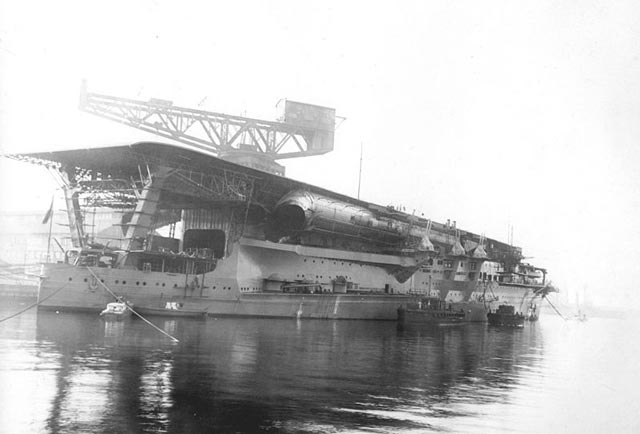 |
| Japanese aircraft carrier Kaga being fitted out in 1928. Visible is a long funnel running underneath the flight deck Also visible are three 8-inch guns in casemates. |
Mitsuo Fuchida's Background
Mitsuo Fuchida was born on 3 December 1902 in Katsuragi, Nara Prefecture, Japan. Reportedly, he was the grandson of a Samurai warrior. Fuchida developed an interest in flying after entering the Imperial Japanese Naval Academy at Etajima, Hiroshima, in 1921. There, Fuchida became friends with classmate Minoru Genda and developed an interest in flying, which was just becoming important in the Japanese military. Fuchida showed promise and aviation was an area of opportunity, so he received rapid promotions after graduating as a midshipman on 24 July 1924. He became an ensign on 1 December 1925, sub-lieutenant on 1 December 1927, and full lieutenant on 1 December 1930.
 |
| Fuchida (age 25, far-right) at the start of flight school in 1927. |
During the Second Sino-Japanese War, Fuchida flew off the brand new aircraft carrier Kaga beginning in 1929 and later for the Sasebo Air Group. During the Second Sino-Japanese War, Fuchida became an expert in the horizontal (as opposed to dive-bombing) form of naval bombing. His reputation growing, Fuchida was made an instructor in level bombing during 1936 and promoted to lieutenant commander on 1 December of that year. Obvious officer material, Fuchida entered the Naval Staff College. After graduation in 1939, Fuchida was named the commander of the aircraft carrier Akagi in 1939. He received his next promotion, to a full commander, in October 1941 during the planning and preparation for the attack on Pearl Harbor.
 |
| Japanese aircraft carrier Akagi, from which Mitsuo Fuchida led the raid on Pearl Harbor. |
Fuchida's Flight to Pearl Harbor
Commander Fuchida was on board the Akagi when Admiral Chūichi Nagumo led the combined carrier battle group,
Kidō Butai ("Mobile Unit/Force"), left Hitokappu Bay on 26 November 1941. The attack force remained on Tokyo time throughout the journey, meaning that for the men on the Akagi it was around midnight when they took off for their attack (although dawn at their location). The planes were prepared on deck the night before under the supervision of Genda, who had planned the operation and would have operational control by radio from the Akagi after they took off (Genda had been scheduled to fly in a torpedo bomber but was scratched for illness). This included putting slips of paper in the radio transmitter gear to ensure radio silence (taken out just before takeoff).
 |
| Commander Fuchida shortly before World War II. |
Fuchida was to serve as the aircrew on this mission, as he had important tasks to perform while his pilot actually flew the plane. While some of the other pilots and aircrew spent the hours before the mission writing letters home that everyone understood could be farewell letters (against Fuchida's suggestion that they get some sleep), Fuchida laid out his flight uniform and then rested for a few hours. He chose a red shirt and red underwear to wear under his uniform to hide the sight of his blood should he be wounded. Fuchida bunked with Lieutenant Shigeharu Murata, who led the first wave dive bombers.
 |
| Nakajima B5N2 "Kate" torpedo bombers flown from the Japanese carrier Shōkaku during the attack on Pearl Harbor. The tail mark 'EI-311' identifies these planes. Shigekazu Shimazaki led these particular planes during the second wave. |
The weather was poor in the morning, and Fuchida later said that ordinarily the mission would have been canceled. As he told a radio interviewer about a month later:
The sun was not up yet and dense, heavy clouds hung over us and over the waters of the Pacific, about one thousand to two thousand meters over our heads. The sea was rough and we could hear the waves splashing against the sides of the ship with a thunderous noise. Under normal circumstances, no plane would be allowed to take off in that sort of weather.
However, this was a special occasion, so the carriers turned into the wind and prepared for launch. The pilots were given a ceremonial breakfast (
sekihan) of rice boiled with small red beans. All of the men then were given special headscarves (
hachimaki) with the word
Hissho ("certain victory") printed on it. They also received special rations for the long flight consisting of rice balls and chocolate.
 |
| Taking off for the 7 December 1941 attack on Pearl Harbor. |
After Fuchida gave them a briefing, the men headed for the planes. Fuchida was to lead the first wave of 183 dive bombers, torpedo bombers, horizontal bombers, and fighters. As Fuchida prepared to get into his Nakajima B5N2 (Kate) bomber, he was surprised by a senior deck officer who gave him a special scarf to replace the ordinary one that all of the participants were wearing. "This is from Akagi's crew. We would like you to honor us by wearing this over Pearl Harbor on our behalf." The scarf had inked upon it the names of all of the Akagi's crew members.
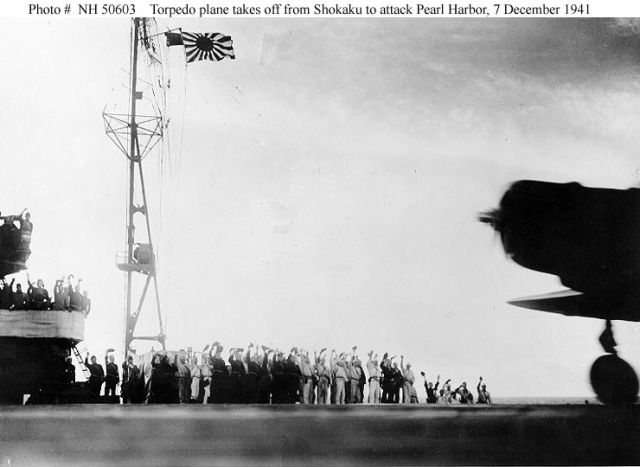 |
| A Japanese plane takes off from aircraft carrier Shokaku for the 7 December 1941 raid on Pearl Harbor to the cheer of the ship's crew (US Navy). |
Beginning at 06:00 local time, the deck crew waved green lamps in a circle to tell each pilot to take off. All 183 planes were airborne within 15 minutes. Fuchida led them the 230 miles south toward Oahu by tuning into the Honolulu radio station, KGMB, which provided helpful weather reports over the islands:
Partly cloudy, with clouds mostly over the mountains. Visibility good. Winds north, ten knots.
For most of the way, KGMB serenaded Fuchida with music which was intended to guide in USAAF bombers approaching from San Francisco, not attacking Japanese warplanes.
 |
| Kahuku Point, Oahu, as the Japanese attackers would have seen it on 7 December 1941 (Google Earth). |
The planes reached landfall at around 07:30, after being airborne for about an hour and a half. Fuchida spotted Kahuku Point on the north shore of Oahu and knew that he was on course. At this point, the attack force split up, with Fuchida leading most of them to the west and south toward Honolulu while a smaller group headed east toward Kaneohe to the southeast of Kahuku. The portion of the attack force heading toward Honolulu also split up into separate formations of dive bombers, torpedo bombers, and horizontal bombers. The fighters followed the dive bombers whose first target was Wheeler Field in central Oahu.
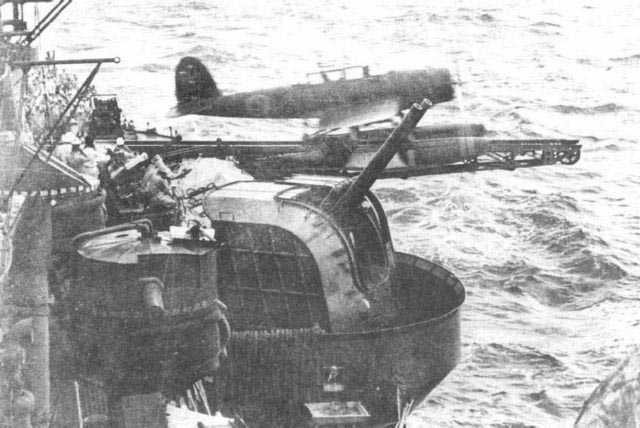 |
| A Type 0 three-seat reconnaissance seaplane (Aichi E13A) was being launched from the port catapult (Type № 2 Model 5) Japanese heavy cruiser Ashigara. The Java Sea, May 1943. |
The planes of the first wave proceeded in a counterclockwise manner. Torpedo planes descended toward sea level, the dive bombers climbed to 12,000 feet, and the level bombers flew just beneath the cloud layer. At 07:38, a floatplane pilot from cruiser Tone that was performing reconnaissance over Maui broke radio silence to inform Admiral Kusaka onboard Akagi that "The enemy fleet is not in Lahaina anchorage." This was good news and meant everything was as expected. The pilot of another reconnaissance floatplane from cruiser Chikuma then reported: "Cloud ceiling over the enemy fleet 1700 meters. Its density is scale 7. Time is 03:08" This time was Tokyo time. He also advised that the US Navy fleet was exactly where it was supposed to be, with ten battleships, ten light cruisers, one heavy cruiser, and various other ships. These estimates were off (there were only seven battleships), but, as they say, it was good enough for government work.
US Army Privates Joseph L. Lockard and George E. Elliott had been watching Fuchida's planes on their radar Opana Station near Kahuku Point for some time. However, the unit's operating schedule ended at 07:00, having been moved earlier in the day due to war fears (previously it ended at 11:30). The truck from their barracks at Kawailoa to pick them up was late, however, so the two men kept monitoring the planes.
 |
| The Opana Radar Site Memorial at Kawela Bay, Oahu, Hawaii, which is quite close to Kahuku Point. The actual site at the top of the hill where the mobile radar was set up is a restricted area. |
At 07:02, Elliott called Fort Schaffer to tell them that he and Lockard were seeing "something completely out of the ordinary." Nobody was around, however, so the operator told Elliott he would get back to him. A few minutes later, watch officer Lieutenant Kermit A. Tyler, a fighter pilot in the 78th Pursuit Squadron, called back and told them not to worry about it because they were bombers expected that morning from California. At 07:39 the large blip was only 20 miles to the north, but now it was no longer Elliott and Lockard's problem. At that point, the truck arrived from the barracks and they shut down for the day.
Fuchida Leads the Attack on Pearl Harbor
Fuchida's plane arrived in the vicinity of Pearl Harbor at 07:41, at which time he broke radio silence and told his radioman to order:
Tenkai! Tenkai! Tenkai!
This translates to "Take attack position!" As planned, Fuchida fired a single green flare from his signal pistol once to give the order to attack. However, when the other planes did not react to this, he figured it may have misfired. Confused, Fuchida fired the flare gun again. The other pilots, however, had seen the first shot, and they also saw the second. This was a mistake on Fuchida's part. A single flare meant that surprise was maintained, while two shots were the signal that surprise had been lost. The pilots of the 53 dive-bombers thus figured they might have a hot reception at their targets of Wheeler and Hickam Fields. However, ultimately the mistake did not make any difference because the surprise was complete. The dive-bombers split off and headed for the airfields while the level bombers led by Fuchida flew over the port.
 |
| A map of Pearl Harbor at the time of the 7 December 1941 attack. Battleship row is at center-right. |
At 07:49, Fuchida again broke radio silence and had his radio operator send:
To, to, to, to.
This translates to "Charge!," a personal signal used by Fuchida and other squadron leaders and not in the official codebook. This was his order to the other pilots to drop bombs. This signal, as intended, was picked up on the Japanese aircraft carriers of
Kido Butai and also in the Navy Ministry in Tokyo, who now knew the attack was beginning. Signals were repeated multiple times to make sure others picked them up over the primitive equipment in use at the time, not to make them seem more impressive to our eyes.
Lots of units used personal signals at that time, things were a little looser than they are today. For instance, on the Channel Front, the pilots of elite Luftwaffe fighter squadron JG 26 would yell "Wutz! Wutz! Wutz!" during air battles. The Allies listening in were puzzled and didn't know what this special code meant. It turned out just to be the first name of Wutz Galland (Adolph's brother), and they would yell "Wutz!" when he did something spectacular (some think he was an even better fighter pilot than his brother). Anyway, I digress.
 |
| In a photo taken by Commander Fuchida, a Nakajima B5N2 Kate flies over Hickam Field and Pearl Harbor during the attack (Photo Source: US Navy). |
When the first bombs hit at 07:53, seven minutes ahead of schedule, Fuchida yelled his famous signal for a successful surprise attack:
Tora, tora, tora.
"
Tora" is an acronym for
Totsugeki Raigeki ((突 撃雷撃) "lightning attack" or, in this specific case, "torpedo attack"). "
Tora" also means "tiger," but that is just a coincidence here and not the meaning intended. Like the earlier "Charge" signal, this signal, one of the most famous in military history, also was picked up elsewhere. It was received on the Akagi and Admiral Yamamoto's signals office onboard the battleship Nagato near Hiroshima, Japan. This signal actually was in the codebook and meant "We have succeeded in a surprise attack." The steward on the Nagato quickly brought out sake and dried squid (
surume) to celebrate. People around Yamamoto, however, noticed curiously that he didn't seem in a particularly celebratory mood.
 |
| This photo by Commander Fuchida shows the destruction caused by the first wave (US Navy Photo # NH 50472). |
Around this time, Flight officer Akira Yamamoto (no relation), piloting one of the escort fighters, scored the first "aerial victory" of the war in the Pacific when he shot down a sightseeing plane over Oahu. Yamamoto and his mates then strafed the fighter planes on the ground at Hickam Field. They were easy targets because they were parked closely together out of fear of sabotage, the theory being that they could be guarded better in a smaller area. Five B5N2 "Kate" bombers were shot down over Pearl Harbor and the Japanese lost 29 planes overall, a small price to pay for the damage caused.
 |
| A Japanese Nakajima B5N2 (Kate) torpedo bomber. These were used at Pearl Harbor and Mitsuo Fuchida flew in one. A B5N2 sank the USS Arizona. |
Having led in the attack force, Fuchida had another important job to do. He was tasked with monitoring the results of the mission and taking photographs of it. His plane was equipped with a special camera mounted on a swivel which he could push over the side of his open cockpit. He could aim the camera using a special peephole cut into the floor of his cabin. However, he remained in overall command, and when he saw a bomber pilot release his bombs early, he flew right next to him and reprimanded the pilot by shaking his fist at him.
 |
| A photo of the Pearl Harbor attack taken by Commander Fuchida. |
It was only then that Fuchida saw smoke trailing from the plane. He used his chalkboard to communicate with the pilot who used his own chalkboard to reply "Fuselage hit." Fuchida ordered the pilot back to the carriers, but the pilot replied that his fuel tank was hit and he was continuing the attack. The other pilot then purposefully dove down to crash into a battleship. On the way, he was again hit by antiaircraft fire and his plane destroyed.
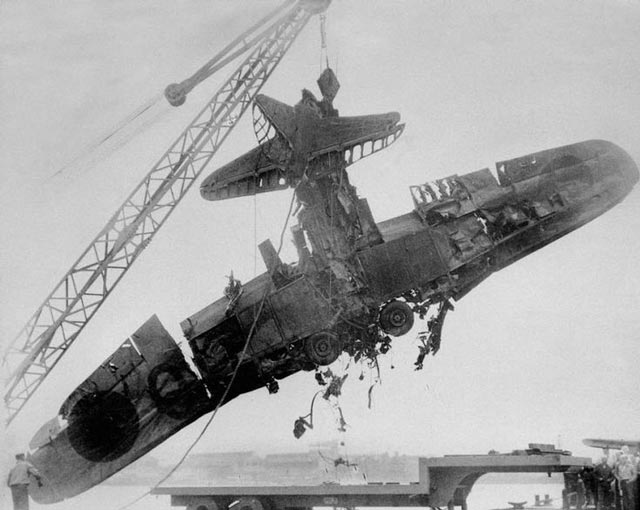 |
| A Japanese warplane dredged up from the bottom of Pearl Harbor after the attack. |
Some antiaircraft fire also hit Fuchida's plane, severing almost all of the rudder control cable. After the battle, the Akagi's crew counted 21 large Flak holes in his plane. Nevertheless, Fuchida continued with his mission, taking invaluable photographs over battleship row. He saw one large ship that "cracked right in the middle. Oil gushed out of the hull of the ship and covered the water with a thick, dark ooze." Fuchida noted that it was "of the Arizona type." It likely was the USS Arizona itself.
 |
| Pearl Harbor's battleship row with ships named. This photo, apparently taken by Commander Fuchida, is early in the attack and shows water ripples from the first hit on USS West Virginia. |
At this point, Fuchida's pilot released the plane's bombs over the battleship USS Maryland. Two of the four bombs hit the ship or were right next to it, while the two others missed. The bomber pilots yelled "
Aturimashita!" (it struck!) over the radio after successful hits. These reports also were picked up on the Akagi and in Tokyo. After this, Fuchida ordered his forty-eight level bombers to head back to base after they released their own bombs. However, Fuchida himself stayed over the harbor to circle the Oahu airfields and look for damage.
 |
| "USS Maryland (BB-46) alongside the capsized USS Oklahoma (BB-37). USS West Virginia (BB-48) is burning in the background. Official U.S. Navy Photograph, now in the collections of the National Archives." Naval History and Heritage Command Catalog #: 80-G-19949. |
Commander Fuchida remained over Pearl Harbor through the second wave, the only first-wave plane to do so. On the way back to base, his plane found two other Japanese planes that had missed their rendezvous point and guided them back to the fleet. Fuchida landed around 12:14 p.m., among the last planes to land. As he landed, Fuchida saw "refueled and rearmed planes ... lined up on the busy flight deck in preparation for yet another attack." After landing, he went up to the flight deck to argue in favor of a third wave targeting the vital fuel storage tanks near Pearl Harbor. Some enthusiastic officers even wanted to head east and attack San Francisco. Admiral Nagumo, however, had seen the damage inflicted by increasing US antiaircraft fire and figured he had taken enough risks. It also was unknown where the US Navy aircraft carriers were. Satisfied with the results, Nagumo turned the fleet back toward Tokyo.
 |
| A 13 October 1941 US Navy photo showing the fuel storage tanks and submarine base that would have been the target for a third wave (Photo # 80-G-182880). |
Fuchida and the leader of the second wave, Shigekazu Shimazaki, were awarded an audience with Emperor Shōwa at the Tokyo Imperial Palace on December 25, 1941.
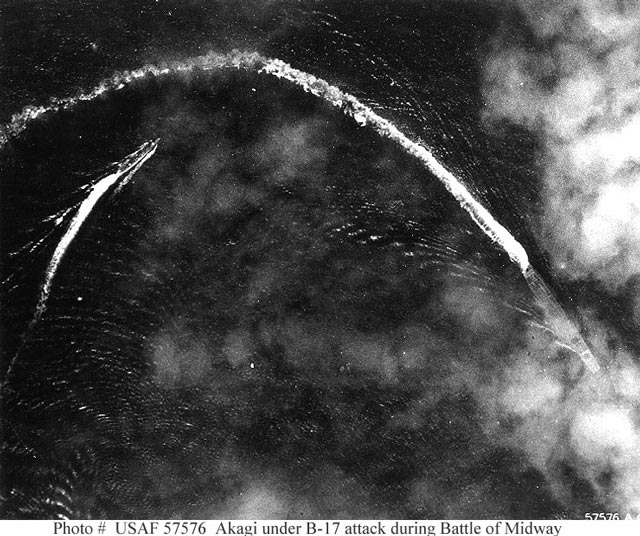 |
| Japanese aircraft carrier Akagi maneuvering to avoid bombs shortly before its sinking at the Battle of Midway. Photo #: USAF 57576. |
Fuchida at Midway and Hiroshima
Commander Fuchida served honorably for the remainder of the war. Fuchida led the very successful air strikes against Darwin, Australia, on 19 February 1942. He also led the successful attack on the Royal Navy base at Colombo, Ceylon in the Indian Ocean in April 1942. Fuchida's luck ran out when he participated in the disastrous attack on Midway Island in June 1942, where he broke his ankle as his ship sank. Luckily for him, he was rescued from the sea when many others were left to drown. Fuchida later published a book about the Battle of Midway ("Midway: The Battle that Doomed Japan, the Japanese Navy's Story" (Naval Institute Press, 2000)) in which he wrote:
Five minutes! Who would have believed that the tide of battle would shift in that brief interval of time? ... We had been caught flatfooted in the most vulnerable condition possible—decks loaded with planes armed and fueled for attack.
Fuchida was extremely lucky to survive the Battle of Midway.
 |
| A B5N2 bomber landing on Akagi after the raid on Ceylon. This may be Fuchida's own plane. |
After Midway, Fuchida essentially was grounded due to his war wounds and made a staff officer. By mid-1945, he was Air Operations Officer for the Navy based in Tokyo. He was in Hiroshima in that role on the day before the atomic bomb was dropped to participate in a conference on the defense of Kyushu. He flew to Nara late that day, 5 August 1945, leaving his assistant behind. At Nara, 500 miles away from Hiroshima, Fuchida participated in a conference to build a new underground naval headquarters being planned outside Tokyo.
 |
| A photograph found at the Honkawa Elementary School taken of the Hiroshima atomic bomb minutes after it was dropped from about 6 miles (10 km) away. |
Shortly after the atom bomb dropped in Hiroshima, obliterating the city, he received a message from Tokyo. It requested that he head back to Hiroshima on a special mission. Naturally, atom bombs were not understood and the dangers of atomic radiation were unknown. The message said that witnesses had reported a second bomb dropped by parachute from a USAAF B-29 that had not exploded. Fuchida immediately flew black, becoming one of the first to see the Hiroshima damage.
 |
| Hiroshima after the atomic bomb, showing the nearby hills where Commander Fuchida found the instrument package (AFP). |
After circling Hiroshima, Fushida flew over the nearby hills where the second bomb had been reported. Seeing nothing, Fuchida and his pilot, Captain Yasukado Yasui, landed at Kure and set out the next morning by truck. About five miles north of Hiroshima up a winding mountain road, they spotted the parachute in some trees. Investigating, the pair found that the parachute was attached to an odd metal cylinder that was not big enough to be a bomb.
 |
| Fuchida late in the war. |
Fushida opened the cylinder by tugging on some metal rings. It turned out to contain electronic instruments such as a thermometer and radio transmitter. This turned out to be a special packaged designed by US scientist Luis Alvarez to measure the performance of the atomic bomb. Fuchida was astonished that the Americans had that much capability, to not only drop the bomb but also measuring devices. He turned and said to Yasui, "Whatever made us think we could beat America?" They then loaded the cylinder into the truck and drove back to Kure. Yasui and some others involved in this operation later died of radiation poisoning, some within 20 days. However, miraculously, Fuchida was unharmed.
Fuchida After the War
Fuchida claimed in his memoirs ("For That One Day: The Memoirs of Mitsuo Fuchida, the Commander of the Attack on Pearl Harbor" (eXperience, Incorporated, 2011)) to have been aboard the USS Missouri during the formal Japanese surrender on 2 September 1945. He wrote:
In my role as Staff of General Navy Headquarters, I was assigned miscellaneous tasks to help the Japanese side's preparations. Since I was not an official attaché, I was watching the signing ceremony from the upper deck along with the crews of the USS Missouri.
Some scholars have disputed Fuchida's presence at the signing. However, Fuchida certainly had the prestige in the Japanese military to merit his attendance.
 |
| Commander Fuchida claims to have been aboard the USS Missouri at the official Japanese surrender of 2 September 1942, but there is no other record of his presence. |
Mitsuo Fuchida was not charged with any war crimes and resented being called to testify in the trials of other soldiers. He viewed this as "victor's justice" and believed that the Americans had acted in the same, engaging in atrocities and treating POWs poorly. However, after a chance meeting with his former flight engineer, Kazuo Kanegasaki, he learned that the Americans had acted correctly and treated prisoners well. In addition, Kanegasaki confirmed that Japanese troops had indeed committed atrocities. Kanegasaki told Fuchida about a Christian woman who had gone out of her way to help in the camp despite the fact that her own parents had been killed in the Philippines in an atrocity.
This and other personal incidents of the same nature had a profound effect on Fuchida. In late 1948, Fuchida read a pamphlet about the life of Jacob DeShazer, a member of the 1942 Doolittle raid who had been taken as prisoner, DeShazer recounted his poor treatment as a POW and attributed to this his own "awakening to God." Fuchida decided to read the Bible, which led him to adopt the Christian faith. He founded the Captain Fuchida Evangelistical Association based in Seattle, Washington and gave spiritual talks. This led to worldwide tours to spread his understanding of the Gospel.
 |
| Paul Tibbets (1915-2007) in front of the bomber named after his mother. |
In 1969, Fuchida met General Paul Tibbets, who had piloted the Enola Gay that had dropped the atomic bomb on Hiroshima. He told Tibbets:
You did the right thing. You know the Japanese attitude at that time, how fanatic they were, they'd die for the Emperor... Every man, woman, and child would have resisted the invasion with sticks and stones if necessary... Can you imagine what a slaughter it would be to invade Japan? It would have been terrible. The Japanese people know more about that than the American public ever will.
Fuchida obtained a green card for permanent US residency but never became a US citizen. He passed away from diabetes in Kashiwara, near Osaka, Japan, on 30 May 1976, at the age of 73.
2019






























No comments:
Post a Comment